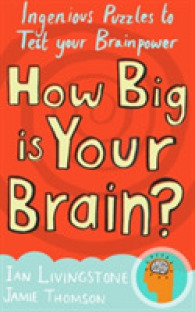- ホーム
- > 洋書
- > 英文書
- > Science / Mathematics
基本説明
A truly interdisciplinary book, it blends neurophysiology, electrophysiological studies, cognitive psychology, psychophysics, and the philosophy of mind, to create a valuable contribution to the field of cognitive science.
Full Description
Ways of seeing is a book about human vision. It results from the collaboration between a world famous cognitive neuroscientist and an eminent philosopher. In the past forty years, cognitive neuroscience has made many startling discoveries about the human brain, and about the human visual system in particular. This book brings many recent empirical findings, from electrophysiological recordings in animals, the neuropsychological examination of human patients, psychophysics, and developmental cognitive psychology, to bear on questions traditionally addressed by philosophers. What is the meaning of the English verb 'to see'? How does visual perception yield knowledge of the world? How does visual perception relate to thought? What is the role of conscious visual experience in visually guided actions? How does seeing actions relate to seeing objects? In the process the book provides a new assessment of the 'two visual systems' hypothesis, according to which the human visual system comprises two anatomical pathways with separable visual functions. The first truly interdisciplinary book about human vision, it will be of interest to students and researchers in many areas of cognitive science and the philosophy of mind.
Contents
PART I: THE PURPOSES OF VISION: PERCEIVING, THINKING AND ACTING; PART II: EMPIRICAL EVIDENCE FOR THE DUALITY OF VISUAL PROCESSING; PART III: PERCEIVING OBJECTS AND GRASPING THEM; PART IV: THE PERCEPTION OF ACTION








